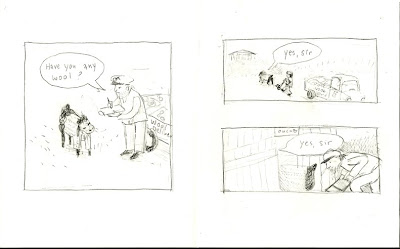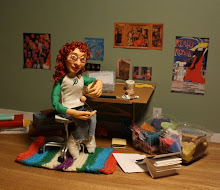The first book we looked at in Megan's Picturebook class was Molly Bang's
Picture This, a book my mom has had around the house since it was published and a book she bought me in the eight grade. In
Picture This, Bang explores how the color, shape, and size of various compositional elements directly affects the emotional response of the viewer. Her beginning example focus on the story of Little Red Riding Hood, while later images explore the differences between diagonals versus horizontals, and round versus geometric forms. For someone who has studied art and sat through critiques, the information in Bang's book is already second nature. What I found most interesting was how non-visual people related and processed the concepts in the book. Watching an adult move pieces of paper around, trying to understand the dynamics of a composition is incredible- even more so in that compositional elements may be something they've never before considered. As an illustrator and intrinsically visual person I find this rather astonishing.
Below is Hansel and Gretel told in 5 pages (and one title page) using the concepts and exercises outlined in Molly Bang's book (one of which is two colors plus black and white, hence the controlled palette).

 Hansel and Gretel’s stepmother, tired of the sound of children playing, sent them into the woods with naught but a hunk of bread. Hansel and Gretel’s father had never let them play in the woods. Afraid they would become lost; they left a trail of bread crumbs behind them
Hansel and Gretel’s stepmother, tired of the sound of children playing, sent them into the woods with naught but a hunk of bread. Hansel and Gretel’s father had never let them play in the woods. Afraid they would become lost; they left a trail of bread crumbs behind them.

But the birds of the forest flocked to food and Hansel and Gretel were soon lost. Spying a house through the trees, they headed toward it and were soon welcomed inside. Though the cottage was sweet, there was something strange about the Old Woman who lived there.

That night the Old Woman grabbed Hansel, cackling, “I do love a good roast child!” Though terrified, Gretel would not see her brother condemned to the oven. As the Old Woman muttered to herself, Gretel reached out, pushing with all her strength, and shoved the Old Woman into the oven, pulling Hansel to safety as she did.

Hansel and Gretel fled the cottage, weaving and twisting through the trees. As dawn approached, they found the edge of the woods.

“Children! Were have you been?” Their father greeted them with hugs and admonishments; “You must never go into the forest alone again. Oh, I missed you so!” Their stepmother, however, was nowhere to be seen.




























 Little Jack Horner
Little Jack Horner



 BaBa Black Sheep
BaBa Black Sheep










